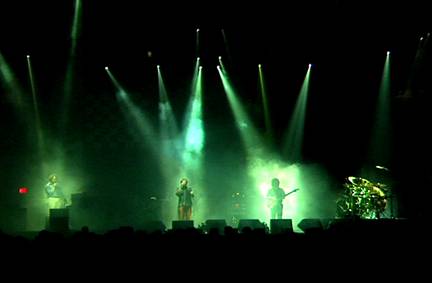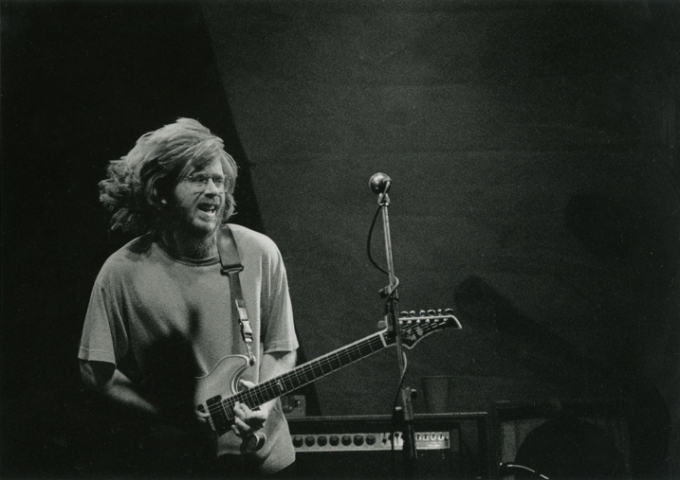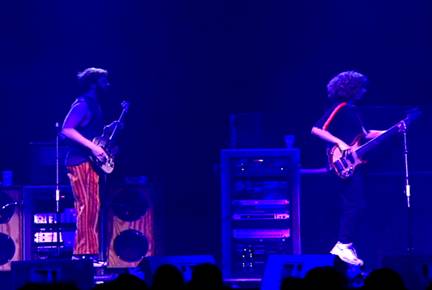In the world of Phish, there are certain months held in a higher regard than all others. Months where the band seemed to tap into an intangible energy bigger than themselves, reach and sustain mediums of connection, and where, simply put, everything clicked. During these months, Phish wasn’t so much playing their music as they were existing within it. Featuring lengthy runs of wildly engaging shows, setlists that read as though they were plucked out of a fan’s notebook, and jams where Phish engaged in a lengthy, unending and fully flowing conversation. These months have come to define the style and sound of the multiple eras of Phish.
April 1992’s west coast tour is probably the first example of a sound being defined within a month, when the band allowed the wide open landscape and desolate valley’s to influence their developing musical experimentation, while highlighting their zany spirit, unyielding energy and psychedelically twisted humor. The breakout month of August 1993’s couldn’t have happened without the band’s mastery the “Hey Hole” jamming technique. 1994 featured dual gems in June and November, the former of which was an absolute apex of the fire and energy of the youthful Phish, and may represent the purest example of the sound Phish was trying to attain throughout their first eleven years of existence, and the latter which displayed a band that had summited the peak of their goals, and instead of plateauing, experimented with their sound, and, for the first time since the mid-80’s, explored what was possible beyond the confines of the structures they’d built and mastered. In this same regard, 1995 gave us two distinct months of brilliance: June which built upon the experimentations of the previous November, and then took the jams to a realm of no-man’s-land that they’ve only been brave enough to explore a handful of times since, and December, which we’ll get to later.
Since 1995, it’s been harder for Phish to produce this kind of consistent brilliance for a variety of reasons. They’ve toured and practiced less which means they’ve had less time to hone in on a new style and develop it, their tours have been shorter, meaning they’ve had brilliant weeks and brilliant shows rather than months, and at times their overall motivation and dedication has come into question. Even still, 1997 gave us the full realization of the funk/minimalist style they’d been searching for since 1995 in the Europe run during June, and the entire fall tour featured a band playing with as little effort yet as much intuitive communication as we’ve ever heard from them. December 1999 was an epiphany in the late 90’s/2.0 era, as the band fused beat-driven jams with minimalism, and combined it with a contagious energy that engulfed the entire fanbase as their millennium shows at Big Cypress approached. Add to it the right amount of darkness fueled by their growing desire to take a break, drug addictions that had taken ahold of two of their members, and a self consciousness that had begun to creep into their songwriting probably due to the previous two factors, and it’s one of the more puzzling, yet intriguing periods of success in their career.
The 3.0 era has produced two more months of unheralded prowess. 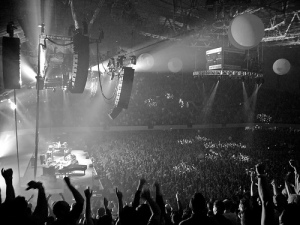 October 2010 was the first month where Phish seemed to fully shake off the rust of a five year break, and embrace what it meant to be Phish again. Particularly from the second night in Charleston, SC on, the combination of small East Coast towns, intimate venues and a resulting youthful energy, the tour was set ablaze with shows chock full of segues, teases, rarities, and some of the most concise, yet expansive jams since the early 90’s. Finally, June 2012 may take the crown as the best month of Phish since December 1997. With a stated goal of playing 200 different songs throughout their summer tour, Phish not only infused each show with fresh songs and setlists, but with some of the most diverse jamming we’ve ever heard out of them.
October 2010 was the first month where Phish seemed to fully shake off the rust of a five year break, and embrace what it meant to be Phish again. Particularly from the second night in Charleston, SC on, the combination of small East Coast towns, intimate venues and a resulting youthful energy, the tour was set ablaze with shows chock full of segues, teases, rarities, and some of the most concise, yet expansive jams since the early 90’s. Finally, June 2012 may take the crown as the best month of Phish since December 1997. With a stated goal of playing 200 different songs throughout their summer tour, Phish not only infused each show with fresh songs and setlists, but with some of the most diverse jamming we’ve ever heard out of them.
And yet here’s the thing, as great as all of the above months were in Phish’s near-thirty year history, December 1995 still ranks as the best month of them all, without question. Coming on the heels of 186 shows in 21 months, with essentially three albums worth of new material, December 1995 is the most polished, confident, and driven Phish there’s ever been. Totally focused on improving with each show, Phish still retained the youthful enthusiasm that had pulled them from obscurity as a college bar band, to theaters and open-air amphitheaters, to kings of the arena rock circuit in just six short years. With an unyielding conviction in the power of their locked-in, total connection concerts, a picture-perfect memory of their complex songs, and a refined approach to the vast exploratory jams of the last year, every show carried the potential to be the best show of the tour and year. As a result, there are no less than ten shows in the month that would find themselves ranked quite high in any list of the best shows the band has ever played.
Turn on any bootleg from December 1995 and the first thing you’ll notice is the torrid energy bursting from your speakers. Featuring 17 shows (including NYE) in their comfort zone of the Northeast, the crowds that came out to their shows were some of the most dedicated, diehard, and loyal fans that Phish has ever had. These were the fans that had seen Phish when they were the quirky yet irrelevant bar band in the 80’s. These were the fans that had traveled throughout New York State, up and down the Atlantic coast, in small towns throughout Pennsylvania, New Jersey, Connecticut, Massachusetts and Vermont, all in effort to support the band and spread word of their greatness. These were the fans who’d watched Phish take the seemingly hopeless risk of driving 2,000 miles to Telluride, CO for a month long stand in a boycotted bar, and then become a national sensation within four short years. These were the fans who packed into Boston’s Exhibition Hall at the World Trade Center to witness their 1990 New Year’s Eve show, only to now await the band’s headlining NYE performance at the most famous arena in the world: Madison Square Garden. These were the fans who’d been there from the beginning, and now were being treated to an entire month of Phish, a Phish that had reached their apex and was using their homecoming tour to throw a month long party.
————
Just for a minute step back and consider the multitude of events that had to go right to create a scenario for a month like December 1995 to occur for Phish, or for any band for that matter. First and foremost, Phish had to form, which means its four members – all from a variety of parts of the overpopulated Northeastern United States – had to meet each other, and see enough potential in their relationships to spend the time playing music together. Then they had to want to continue playing music together. Not want in the way of casually enjoying hanging out with someone, but fully believe that their other three counterparts were talented enough, passionate enough and driven enough to continue working – keyword: working – toward some obscure, intangible, somewhat undefinable goal. No matter what direction they would decide to take their music, they had to keep working at it to move forward. Working at it when all looked hopeless and they had graduated from college – burdened with the added pressures of adulthood and careers, mortgages and marriage, blah blah blah – and were still overjoyed when just 2000 people came out to see them play. One Time. Working at it when their hard work began to pay off, when they began to make money, and began to develop some sense of a national following, rather than allow the success to get to their heads. Working at it even when they surpassed probably their own wildest imaginations of what they could be, in April 1992, in August 1993 and again in June 1994. Working at it day in and day out in the way an elite basketball team works on defensive schemes long after practice was scheduled to end. Working at a craft in a focused and driven manner all in the name of creating the music that played in their heads in a live, improvisational setting.
What’s more is that the decisions they made along the way, in the years and months leading up to December 1995, had to match both their practical needs as a band, and push them further along the path they’d traversed. Decisions such as Trey’s acceptance of Page into Phish in 1985, when, after stating that Phish was a “two-guitar band,” he realized that Page’s keys offered a different dynamic to his melodies, and would provide him with a partner to create multi-layered textures, intertwined conversation pieces, and rousing, anthemic jams over the rock-hard rhythms produced by Mike and Fish. Trey’s decision to halt his devotion to, and covering of, The Grateful Dead in 1986, a move that forced Phish to focus more on crafting their own sound. Their five performances of their mini-opus, Gamehendge in 1988, 1991, 1993 and 1994, along with their never-ending gags centered around songs that Fishman despised, and their insistence on including their fans as much as possible in their New Years and Halloween extravaganzas created a sense of unity, of brotherhood, an unbreakable bond between them and their fans.
Musically, their expansive sounds and jams of 1987 and 1988 gave way to a refined approach in 1989 through 1992 wherein which they wrote three albums worth of music – and then some – and focused on tightening their live sound. Demanding perfect communication, skillful agility, airtight segues, relentless energy, a heaping dose of tongue-in-cheek humor, and stop-on-a-dime precision, Phish transformed their sound to that of a well-oiled machine, crafting shows full of musical peaks, professional acumen and nonsensical gags. By 1992 one was more than guaranteed to be blown away walking out of a Phish show. A far more engaging experience than the lonerism spirit of the grunge scene, far less expensive and far more technically impressive than the big name rock and pop groups that catered to the masses. Phish wore their irrelevancy and isolation at the time like a badge of honor. And by the winter of 1993, their dedication paid off in full, as can be heard most notably in their February 20th show at the Roxy Theatre in Atlanta, GA. Taking a leap forward in the confines of a single show in a way they hadn’t ever before, Phish fused the tight and explosive sound they’d crafted over the previous four years with the exploratory origins they’d been founded in. Wielding a set of segues, teases and jams in and out of “Tweezer” and “Mike’s Groove,” a porthole opened. Phish would never be the same.
From there the band would only continue to build upon their sound in an obsessive search to craft music that displayed the band as not four individuals playing music, but as a unified force playing as one. It is this goal which could only be realized after shedding their improvisation roots in 1989 and building themselves back up as a tight and edgy rock band, but wouldn’t be actualized in part until December 1995, and then in full in 1997. August 1993 gave the band their first headlining summer tour of the nation’s concrete, open air amphitheaters which in turn gave them the space to stretch their music in ways they hadn’t before. Moreover, their fanbase had more or less been solidified by now, allowing them the comfort and confidence that they’d have a passionate and loyal crowd awaiting their every show. From here they sought out new fans, infusing their shows with an array of popular covers, exploring the endless musical diversions their songs could traverse, and including everyone in the poignant and intriguing myths they’d crafted in their college years – from Col. Forbin climbing up the mountain to save Gamehendge, to Poster Nutbag and Jimmy’s unending battles against Harpua. Their shows were transformed from simply high-energy workouts to events that meant something, where anything-could-and-would-go. A single song that had been played with a similar enthusiasm for five years, say, “Bathtub Gin,” became, on nights like August 13th 1993, an unending journey into the unknown, opening up vast cavernous vaults of potential for exploration and mind-bending music.
And yet, they still kept growing. From the wide-eyed musical successes of 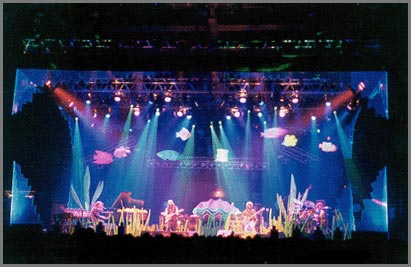 1993 came the renaissance of 1994. After taking the Fall and Winter of 1993 off – spare the historic NYE run that also served as a veritable THANK YOU!!! to the entire Northeast – to record Hoist, they booked themselves 123 shows, criss-crossing the country not once, not twice, but three separate times in effort to spread their collective energy, planned a Halloween show in which they would don a musical costume, crafted the blueprint for their eventual multi-show festivals, built upon the exploratory journeys unleashed the previous summer, played their first of now 27 shows in the world’s most famous arena, and ultimately compiled a year that would be considered far and away the best of any other band’s career.
1993 came the renaissance of 1994. After taking the Fall and Winter of 1993 off – spare the historic NYE run that also served as a veritable THANK YOU!!! to the entire Northeast – to record Hoist, they booked themselves 123 shows, criss-crossing the country not once, not twice, but three separate times in effort to spread their collective energy, planned a Halloween show in which they would don a musical costume, crafted the blueprint for their eventual multi-show festivals, built upon the exploratory journeys unleashed the previous summer, played their first of now 27 shows in the world’s most famous arena, and ultimately compiled a year that would be considered far and away the best of any other band’s career.
One of the most important decisions the band made in 1994 was not a musical or stylistic one, instead it was a logistical decision that would help to alter the course of their music and career forever. In the previous ten years of their existence, they’d always used the Fall tour as a homecoming tour of sorts. After spending the majority of the year on the road spreading their sound, their tours would always wrap back to the confines of the Northeast – the 1992 Fall tour is the lone black sheep in this category, it concluded in Montreal, not exactly their home turf, but still, close enough to the Vermont border – a supercharged homecoming celebration of sorts. However, in 1994, following their monumental Halloween show in Glens Falls, NY Phish began a journey westward that would conclude over a month later in Santa Monica, CA, and wouldn’t bring them back for a show on the east coast until December 28th. The decision was reminiscent of their college-era practice sessions where they would lock themselves in a room for hours, jamming non-stop in effort to understand the musical tendencies of each other and the patterns they could create. By separating themselves from their home base, and traversing into the wide, expansive West, they released themselves from all expectations, and dove headfirst into a musical experiment they’d been training for since 1989. Using the open-ended structures written into some of their best known songs – most notably, “David Bowie” and “Tweezer” – they allowed themselves to be taken over by the possibilities that lay within vast portholes of their songs. A decision made, consciously or not when they wrote their earliest classics, pockets of space were left open within their complex structures that years later – after the band had reached a point of mastery within their songs – were suddenly thrust open and used to dive deeper into the unknown than they may have thought possible. The tour was a revelation into how far they could take their music, how lost they could get within the medium of a live concert, how far away from themselves, their own personal wants and needs, their own self consciousness they could go.
When they returned to the stage in June of 1995, Phish built upon this exploratory revolution to their sound, infusing the entire tour with an array of jams that stretched out further, wider, into deeper and darker realms than they ever had before, all in the name of a linear musical communication. Entire sets were sometimes engulfed in this singular goal, nearly every show contains a massive 25+ minute foray into the unknown, and for perhaps the first time ever, Phish played without a sense of care of anyone watching them. Most likely turning away a number of fans, the band believed that the decision to take such extreme risks each night would pay off in the future. Putting everything on the line every single night, Phish bared their souls to their audience in ways they never had before. No longer locked in a room together, no longer in search of musical perfection, no longer worried about sustaining themselves financially through their creativity, no longer worried about building a national following, Phish was completely free to use their shows 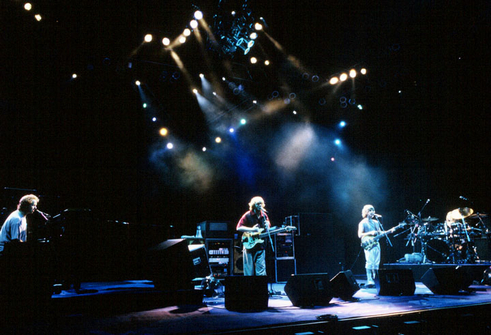 as an opportunity to dive head first into the unknown, fuck all the consequences. In the end the tour is one of the most divisive and controversial in their history. Some fans can’t stand the sound of the band 30-odd minutes into a “Tweezer”. Some can’t grasp the fact that their second sets started featuring less songs than fingers on a hand. Some fans wither in terror at the self-indulgent experiments, much of which produced music that many consider to be unlistenable. Yet others view it in reverence, the one moment where Phish was clearly at the top of their game in terms of musical chops, and blended it with a divine and twisted hurdle into the unknown. Whatever way you look at it, the decision to continue and expand upon the explorations of 1994 had a profound impact on the history of the band. This was Phish deconstructing themselves once again in front of our eyes. Yet where 1989’s house cleaning was conducted in effort to sharpen their catalogue and inject a massive supplement of energy into their shows, the purpose of June 1995 was to move past the music they’d written, and try to simply understand music from a basic level. The goal in all of this was the aforementioned search for a style and a sound that allowed Phish to play as a unified instrument of linear communication.
as an opportunity to dive head first into the unknown, fuck all the consequences. In the end the tour is one of the most divisive and controversial in their history. Some fans can’t stand the sound of the band 30-odd minutes into a “Tweezer”. Some can’t grasp the fact that their second sets started featuring less songs than fingers on a hand. Some fans wither in terror at the self-indulgent experiments, much of which produced music that many consider to be unlistenable. Yet others view it in reverence, the one moment where Phish was clearly at the top of their game in terms of musical chops, and blended it with a divine and twisted hurdle into the unknown. Whatever way you look at it, the decision to continue and expand upon the explorations of 1994 had a profound impact on the history of the band. This was Phish deconstructing themselves once again in front of our eyes. Yet where 1989’s house cleaning was conducted in effort to sharpen their catalogue and inject a massive supplement of energy into their shows, the purpose of June 1995 was to move past the music they’d written, and try to simply understand music from a basic level. The goal in all of this was the aforementioned search for a style and a sound that allowed Phish to play as a unified instrument of linear communication.
Tragically, the death of one of Phish’s greatest influences, and one of the most significant figures in the music they’d dedicated more than ten years to – Jerry Garcia – did more to bring Phish into the mainstream than anything they’d done themselves throughout their career. Suddenly there was a surge of fans who’d never cared much about Phish’s punky, aggressive and ironic approach to music that jumped on tour in search of the next party bus. With this onslaught came a need for larger venues, and their shows began to take on a larger than life feel. The fall tour that followed essentially featured two Phish’s. The first, in their October journey from California to Chicago, found them toning down the experimental diversions of the summer in favor of a sound that blended of the torrential energy of their ’89 – Summer ’94 shows, with a dose of psychedelia that overtook Summer 1995. They became a band in search of something once again, reaching it inconsistently, yet ultimately hinting at the brilliance that was just around the corner. In many of the same ways that Fall 1996 would hint at the organic cow funk that would fully bloom in 1997, October 1995 gave glimpses of how powerful Phish would be once they got rolling. Taking a ten-day break after their explosive Halloween show in which they flawlessly played The Who’s Quadrophenia was a key move to rest and prepare for the two month trek ahead of them.
Where Fall 1994 was a journey of westward expansion, Fall 1995 was a marathon from Atlanta to Lake Placid. Five weeks, 15 States, 29 shows, all concluding with a 13 show run through their New England homebase. It was the culmination of 13 years of practice, travel, more practice, unending energy, drive, commitment, friendship, trials, heartaches, weddings, shows in front of no one, more hungover drives across two states in one day than anyone wanted to remember, more practice, shitty food, a singular belief that what you were doing was right, loans, more practice, all leading up to a month in which the band played the best music they’ve ever played at the highest level they’d been at to that point, in front of the people who’d been there from the start: their friends, family and fans who’d given everything to hear the intoxicating, uplifting and uncompromising music of Phish.
————
Tearing through the southeast and up the Atlantic coast throughout November, every show, every week Phish was on the road seemed better than the last. To claim that December is superior than November is somewhat unfair when discussing the Fall 1995 tour. November is the overlooked calm before the storm. By all accounts, if the tour had ended on November 30th 1995 in Dayton, OH, it would have been heralded as a unanimous success. From the torrential energy of 11/11/1995, to Orlando’s second set dive into the unknown in “Stash” on November 14th – a jam which built into a take on “Manteca” that just might be the first example of the cow funk entering Phish’s repertoire – to the Carolina’s brilliant “You Enjoy Myself” and “Tweezer” on back-to-back nights, to the 30+ minute “Free” that took over the second set in Landover, MD on the 22nd, to their first show at the hallowed Hampton Coliseum in Hampton,VA during Thanksgiving week, to Bela Fleck’s memorable sit-in in Knoxville, TN on the 29th, to the 30th’s manic first set that spilled over into the masterful “Tweezer -> Makisupa Policeman -> Run Like An Antelope” in set II, there were more than enough memories and monumental performances throughout November to end 1995 on a high note.
Yet, this is what makes December 1995 so special: they just kept going. They’d harnessed the fire, and as they’ve proven so many different times, in jams, in tours, in shows, if they just keep going, if they just keep focused, if they keep searching for the next plane of creative bliss, sooner or later they’ll reach it, and when they do, look out. From the moment they stepped on stage in Hershey Park Arena on December 1st, to the last note of “Runaway Jim” seventeen days later in Lake Placid, from the first roll of the signature drum pop of “Split Open & Melt” in Worcester, MA on the 28th, through “Johnny B. Goode” in the early hours of 1996, everything Phish played carried a sense of grandeur, a greater collection of energy, a more meaningful purpose than most anything they’d played up until that point. Nearly every show is a classic. You can’t call any show a bad gig, you struggle to be overly critical of any show at all. Throughout the entire month, it mattered little what songs they actually played, every song, be it “Down With Disease,” “Tweezer,” “Scent Of A Mule,” “NICU,” even “Poor Heart” contained a burst of energy and an opportunity to be explored like never before. For seventeen glorious nights, Phish resided at the summit of the mountain, made even sweeter by the fact that they were performing nightly in front of the people who had supported them throughout their entire rise. There’s simply no parallel to the month in any other period of their career. Even December 1997 – a blissful return to the summit, which we’ll dive into in the next post – lacked the certain something that made December 1995 what it was. While the sound they’d worked so hard to build until 1992 – a sound that they would spend the next three years toying with, constantly one-upping themselves – would linger in some form through The Clifford Ball the next summer, it never quite sounded so rich, so powerful, so expansive and so tight as it did throughout December 1995.
– Jams –
If one were to sum December 1995 up into a singular jam, one might suggest the 12/02/1995 “Tweezer” which builds in Type-1 tension & release fashion to a masterful explosion of guitar hose, or the 12/07/1995 rhythmic and soaring melodies “Mike’s Song -> Weekapaug Groove,” or perhaps the 35 minute “You Enjoy Myself” that engulfed the second set of the 9th’s show at Albany and featured such lock-tight connection that they were able to incorporate almost two minutes of silent jamming before reawakening the jam, or even the 31 minute “Down With Disease,” only the second time the song had been played since June, and the last exploratory version until the European Winter tour of 1997. And yet, for as remarkable, mind-bending, and infectious as those jams were, they are not Binghamton’s “Halley’s Comet -> NICU -> Slave To The Traffic Light” from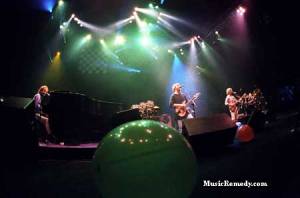 December 14th.
December 14th.
Playing a tiny minor league hockey arena where they’d played one of their best shows of 1992 – 03/20/1992 – the show carried that extra something that lingers in the air at all classic Phish shows. The frigid temperatures outside, the college crowd/forgotten rust belt vibe of the town, it’s geographic location: 90miles south of Syracuse and the 1-90 corridor, SE of the fabled Fingerlakes, the cramped, archaic and swampy conditions inside the venue, it was all a part of the culture that made Phish.
On paper the triumvirate doesn’t look that out of place – save for the direct segue into “Slave” – it appears as the kind of sequence one would envision happening without much fanfare at any number of shows. The burst into “NICU” out of a :30sec guitar build in “Halley’s” is none too uncommon during the 3.0 era. However, from the moment the lyrics in “Halley’s” conclude it’s clear the band is on a mission as Trey swiftly directs them away from the bubbly pop of the song into a high-octane charge into the unknown. Traversing through various speed-jazz phrases, Mike takes a step back and opens the space up considerably, before Trey reinvigorates the jams with an infectious and insatiably catchy riff to which each member hooks onto, thus shifting the jam into a rousing display of unity and communication. This riff, and the resulting jam – just over two minutes in length – represents everything about December 1995 that was so special. In the midst of a jam on a song that is normally treated as a quick punch for energy, the band embraces the unknown fully, allows one jam to develop but then cuts it off abruptly. On a dime they are following each other, waiting patiently, and then, when they know Trey’s struck musical gold, jump on his new idea, building a segment of music out of it that features total engagement and sounds as though it were composed over a lengthy period of editing and rewriting. Were it prewritten would take away very little of it’s greatness, yet the fact that it’s a completely spontaneous event makes it all the more surreal to listen to and contemplate.
From there, Trey directs the band into “NICU,” a song that was notable for being something of a rarity at the time, yet one that few would expect to find buried deep in a second set. Receiving the same treatment as “Halley’s” as soon as the lyrics end, “NICU” goes on a wild adventure from 4:25 to it’s fade into “Slave.” Jumping on the exact same theme from “Halley’s,” Trey builds the song in much the same way as he did in it’s predecessor, though this time, instead of following his every note, Page, Mike and Fish add an atmospheric background to his melody, maturing the theme on the spot, and giving it a more well-rounded, structural feel. Deconstructing it after reaching its maximum potential, Page take’s the reins on the baby grand and guides the band out of fuzz-rock and into more refined and regal territory before Trey and Mike return with ambient phrasings, fading into a stirring, patient and ultimately fulfilling “Slave” to end the sequence and the set.
If the “Halley’s -> NICU -> Slave” trio is the undisputed jam of December 1995, then the “Bathtub Gin -> The Real Me -> Bathtub Gin” from December 29th is at worst, the undisputed jam 1a. After coming alive in the Murat Theater in Indianapolis back in August 1993, “Bathtub Gin” had cooled considerably, returning to it’s role as mid-first set Type I clinic is HOSE. Save for the rousing version sandwiched around the bust out of Mingus’s “Jump Monk” on 04/24/1994, the song remained quite contained for over two years. Yet as the band returned to the road on November 9th in Atlanta, they brought “Gin” back into the realm of improv as well. Both the 11/09 and the 12/05 version from Amherst left the “Gin” theme completely, engaging in, first, an anthemic hose section before stripping away excess noise and focusing on the infectious rhythms contained within the songs origins. The December 5th version then built upon the uncharted terrain, guiding the jam into an obscure, noise-ladened territory, allowing each member to explore the bottom ends of their instruments, while dissonant washes hung overhead.
Following a similar dance-heavy pattern of the previous two versions, “The Real Gin” pushed through various segments of high-octane hose before Trey discovered a tight riff that each of his counterparts jumped on, dedicated to building the theme ala the Binghamton “Halley’s.” The riff serves ultimately as a transition into a cover of The Who’s “The Real Me,” yet what makes the segment so special is the fact that the transition emerged out of a collective search for communication, and wasn’t until everyone jumped on the idea that Trey was trying to communicate that the segue unveiled itself to them. The perfect match for a “Bathtub Gin” jam, the energy within the room – both onstage and off – reaches almost unsustainable levels of pure joy and ecstasy. The band harnesses a power only previously reserved for the arena rock bands of lore, and for a moment epitomizes the entire sound they’d been searching for to accompany their transitional state from clubs to arenas. It’s the kind of music they could have never played in a small theater in 1992. It’s the kind of music they could never have played at the Gorge in the summer of 1998. It’s the kind of music they could never have played during the winter of 2003. It’s the kind of music they could never have played in August 2011. It’s wholly original and unique to where the band was in December 1995, and it represents the kind of elation and sustained energy that had overtaken Phish throughout the month. In the industrial heartland of Massachusetts, in the venue – The Centrum – that had housed one of the greatest shows of their first ten years – 12/31/1993 – two nights before maybe their best show of all time – 12/31/1995 – at the peak of their power, fully locked into their goals, with a purpose that you just don’t see out of a lot of bands once they’ve “made it,” “The Real Gin” represented yet another one of those moments where the band was simply a vessel for tapping into a higher power. Just listen to the way Trey screams “Can you see the real me?! Doctor?!! Whooooa DOCTOR!!” to a wave of continual cheers from the crowd before the band turns on a dime, breaks the song down to Fish and Trey and perfectly pivots into the second verse. A song they’d only played once before – two months earlier – a song that had probably not even been considered for the setlist, a song that emerged from a jam that wouldn’t have even happened had Trey not gone forward with a brief idea of his, and had his bandmates not latched onto his idea fully, thus building the “Gin” into “The Real Me.”
Then, as if the powerful segue, and surprise performance were not enough, the band took The Who on a wild ride through a torrential guitar solo, arena rock excess, before deconstructing it into a funk-laced jam that emphasized linear communication in its greatest sense. Finally, in the same way that “The Real Me” found it’s origins in the “Gin” jam, Trey directs the band into a rhythmic territory based off of a riff of his that bleeds patiently, yet flawlessly back into “Bathtub Gin.” A masterful moment in composition, it is as professional an assertion on the power and command of Phish in December 1995, of both their arsenal and knowledge of each other. A monumental excursion, a clear victory for both the band, and for the world of improvisational music. Proof that what they’re doing isn’t so much “jamming” as it is conducting into the unknown. A jam that has lived on in infamy, known simply as “The Real Gin” to fans, it’s yet another example of the power and supremacy that was Phish in December 1995.
– Shows –
As was stated above, there’s really no such thing as a bad show in December 1995. Even the weakest shows by most people’s standards – 12/04/1995, 12/08/1995, 12/16/1995, 12/28/1995 – are still really really good shows by any other month’s standards. More than anything, these four shows have the misfortune of being included in the conversation with December 1995. This embarrassment of riches creates a problem when attempting to sum the month up in a single show. There are simply too many good shows to discuss when talking about December 1995. You could talk about the 12/01 explosion of energy, full of incredible jams in “Mike’s” and “Bowie,” and the right dose of Phish mythology in “Col. “Forbin’s,” or the rarities scattered throughout 12/07, combined with a unique setlist and timeless jams in “Split Open & Melt,” and the “Mike’s -> Weekapaug” sequence. You could talk about 12/11’s return to Portland, ME, where a gag on “Dog Log” took over the first set, while the second set was dominated by a scintillating and electrifying “Bowie,” or the jam-packed tour finale in Lake Placid which opened with the absolutely torrid segment of “My Friend>Poor Heart>A Day In The Life>Antelope” and closed with a 20 minute jam out of “Tweezer” and led, for only the third time ever, directly into “Tweezer Reprise.” You could also talk about 12/29’s old school, celebratory explosion – a show that defines the ultimate feeling of a Phish holiday run, and continued the lore surrounding the 12/29 and 12/30 shows on a NYE run – or you could talk, however obviously, about the pure greatness of 12/31, from the fact that it was their first NYE show at MSG, to the near-flawless performance of some of their classics, to the diversity and multitude of jams in “Drowned,” “Runaway Jim,” “Mike’s Song,” “Weekapaug Groove” and “You Enjoy Myself.”
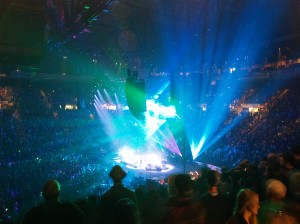 Yet, to really sum up the entire month of December in one Phish, one should look no further than the insatiable command, and frantic explosions that emit from their one-night-stand in Philadelphia, inside the legendary Spectrum, on December 15th. Opening with “Chalk Dust>Hood>Wilson” is enough to straight blow the lid off the old bitch. But to then build the first set through a series of some of Phish’s most raucous songs, refusing to let enough time pass between the conclusion of one song and the start of another, so that the crowd only has an opportunity to react once the next song’s started, cultivated a live test in the amount of energy, pressure and elation one could unleash on a crowd before they would explode. “Maze>Ha Ha Ha> Suspicious Minds>Hold Your Head Up>Cars Trucks Buses>Bouncing Around The Room, Free>Possum” concluded a set that, like much of the rest of the month, mattered little for song choices, and instead relied totally on the ferocious output by the band. Opening the second set with “Tweezer Reprise” carried much of the celebratory vibe from set one to part two, and was sustained through a twisted take on “It’s Ice,” and a spirited “Bathtub Gin” that evolved into a beautiful “Rotation Jam” before seguing into the only known version of the Fishman ballad “Mallory.” Concluding with the classic combo of “2001>Bowie” – the latter of which exemplified the contained, yet exploratory nature of the composition – the show is full of literally everything that makes December 1995 the month it is.
Yet, to really sum up the entire month of December in one Phish, one should look no further than the insatiable command, and frantic explosions that emit from their one-night-stand in Philadelphia, inside the legendary Spectrum, on December 15th. Opening with “Chalk Dust>Hood>Wilson” is enough to straight blow the lid off the old bitch. But to then build the first set through a series of some of Phish’s most raucous songs, refusing to let enough time pass between the conclusion of one song and the start of another, so that the crowd only has an opportunity to react once the next song’s started, cultivated a live test in the amount of energy, pressure and elation one could unleash on a crowd before they would explode. “Maze>Ha Ha Ha> Suspicious Minds>Hold Your Head Up>Cars Trucks Buses>Bouncing Around The Room, Free>Possum” concluded a set that, like much of the rest of the month, mattered little for song choices, and instead relied totally on the ferocious output by the band. Opening the second set with “Tweezer Reprise” carried much of the celebratory vibe from set one to part two, and was sustained through a twisted take on “It’s Ice,” and a spirited “Bathtub Gin” that evolved into a beautiful “Rotation Jam” before seguing into the only known version of the Fishman ballad “Mallory.” Concluding with the classic combo of “2001>Bowie” – the latter of which exemplified the contained, yet exploratory nature of the composition – the show is full of literally everything that makes December 1995 the month it is.
If only to add to the musical mastery of the show was the locale. Born and raised in Princeton, NJ, Trey was a die-hard Philadelphia Flyers fan from a young age. No doubt won over by their back-to-back Stanley Cup titles in 1974 and 1975 – the first of which featured the first victory of an expansion-era NHL team over an Original Six franchise, when they beat the Rangers in seven to advance to the Finals before beating the Bruins in six to claim Lord Stanley – he grew up playing hockey and made the hour-long drive to Philly frequently to cheer on the great Flyers teams of the 70’s. What’s more is that Trey’s first live show was a Jethro Tull show at the Spectrum. A venue that was held in the highest regard until it’s closure and demolition in 2010, it was a favorite of many of the arena rock groups of the last forty years, and was the kind of venue one showed-up to whenever they’d booked a gig there. Legends were made there, and one did not look lightly upon a performance at a venue like this. Combine this personal history with the fact that the show was their 180th since April 1994, near the end of their greatest tour ever, and it’s no wonder such magic was unleashed in Philly this night. It’s yet another example of the intangible power and energy that is unleashed during a Phish show. It’s a perfect microcosm to essentially sum up what made December 1995 so unique in their history.
Certain venues and cities bring out different qualities within Phish. The Gorge allows for them to be overtaken by the vastness of the surroundings and usually results in shows heavy in experimentation, Deer Creek is their inheritance from The Dead – an intimate amphitheater in the heartland of America – MSG is the pinnacle of their rock star personalities, used to punctuate another year gone by and remind all other bands of that untapped power of Phish. Philly’s Spectrum however is what Phish would be if they were a venue. Located in an often overlooked city – Philadelphia – under appreciated by the masses, unpreserved by those in care of it, understood and adored by those who take the time to truly appreciate its intricate nature, and lovable flaws. When they stepped inside of it for each of the nine show they would play there, the spirit and the energy of the venue overtook them, and – aside from two horrendously weak shows in 2003 – resulted in one of the best shows from its respected tours.
Fusing the telepathic communication of the members of Phish with the absolute mastery of their technique, the home stretch of their Fall 1995 tour with their location, their first performance in a venue of their dreams with the holiday season in full swing, and it’s no wonder that 12/15/1995 produced one of the most memorable shows of the tour and month. What’s more though is how it represents literally every aspect of Phish in December 1995 that made that era so special and so unique. Never before and never since has the formula added up in quite the same way as it did in December 1995. This is not to say that they haven’t produced music over stretches before or since that demand listening, but there is something to be said about the fact that December 1995 displayed a Phish at the absolute apex of their talents, yet still in search of a larger goal. In the region that bore them and raised them up, it all combined to create the best month Phish has ever played.
